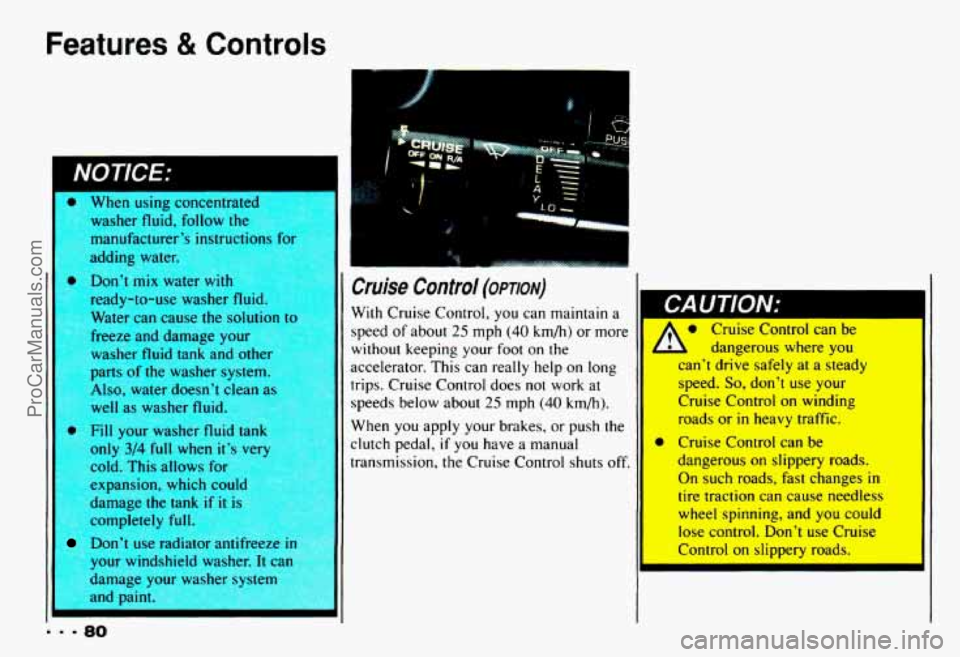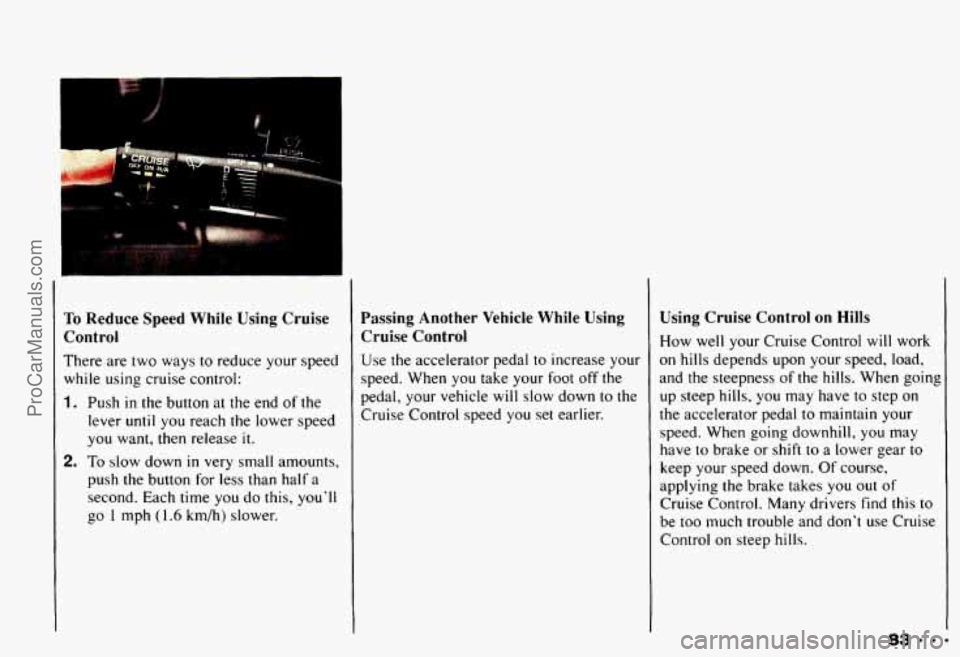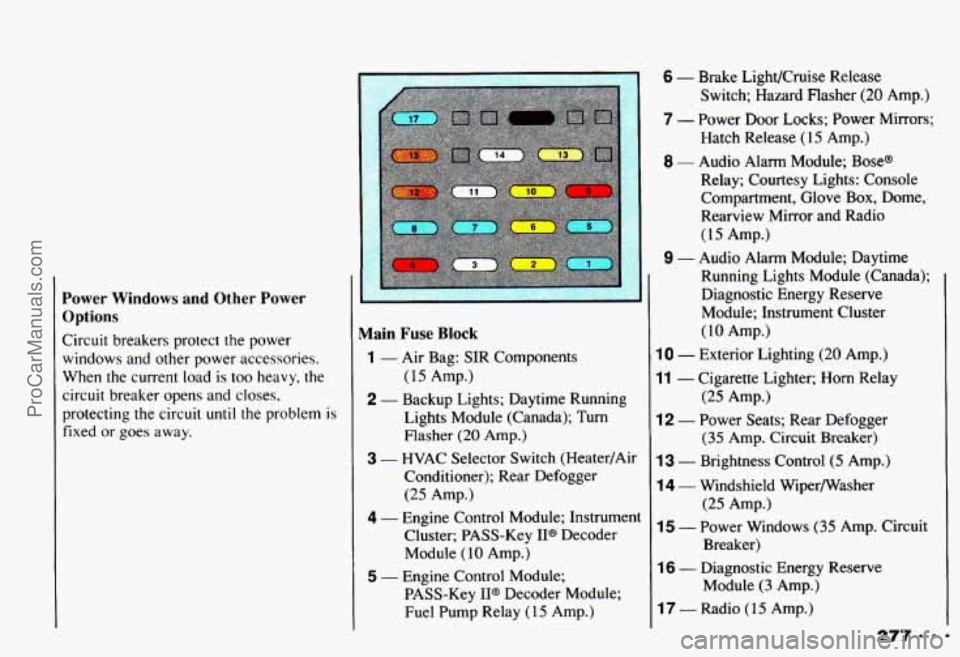Page 81 of 358

9
The Turn
SignaUHeadlight
Beam
Lever
The lever on the left side of the steering
column includes your:
0 Turn Signal and Lane Change
0 Headlight Highbow Beam and
Passing Signal
0 Windshield Wipers
0 Windshield Washer
0 Cruise Control (Option)
Indicator
c; C. , .“ ,
i
I:
rum Signal and Lane Change
ndicator
’he turn signal has two upward
(for
tight) and two downward (for Left)
lositions. These positions allow you
to
ignal a turn or a lane change.
b signal a turn. move the lever all the
vay up or down. When the turn is
inished, the lever will return
.utomatically.
A green arrow on the instrument panel
will flash in the direction of the turn or
lane change.
To signal a lane change, just raise or
lower the lever
until the green arrow start:
to flash. Hold it there until you complete
your lane change. The lever
will return by
itself when you release
it.
As you signal a turn or a lane change, if
the arrows don’t flash but just stay on, a
signal bulb may be burned out and other
drivers won’t see your
turn signal.
If a bulb is burned out, replace it to help
avoid an accident.
If the green arrows
don’t go on at
all when you signal a turn,
check the fuse (see “Fuses” in the Index)
and for burned-out bulbs.
ProCarManuals.com
Page 84 of 358

Features & Controls
II
washer fluid, follow the
manufacturer’? instructiopc
fnr
adding water.
Don’t mix warGI with
ready-to-use washer
fluic..
Water can cause the solutinn tn
freeze and damage your
washer
fluid tank and other
parts of the washer systen
Also, water doesn’t clean as
well as washer fluid.
Fill your washer fluid tank
only
3/4 full when it’s ver
cold. This allows
fo
expansion, which COUI(
damage the tank if it is
completely full.
Don’t use radiator anurreeze In
your windshield washer. It can
and paint. damage yolw
wacher cvctpm
-=-8O I
Cruise Control (opmv)
With Cruise Control, you can maintain a
speed of about
25 mph (40 km/h) or more
without keeping your foot on the
accelerator. This can really help on long
trips. Cruise Control does not work
at
speeds below about 25 mph (40 km/h).
When
you apply your brakes, or push the
clutch pedal,
if you have a manual
transmission, the Cruise Control shuts off.
Cruise Control can be
1 L dangerous where you
can’t drive safely at a steady
speed.
So, don’t use your
Cruise Control
on winding
roads or
in heavy traffic.
dangerous
on slippery roads.
On such roads, fast changes in
tire traction can cause needless
wheel spinning, and you
could
lese control. hn’t use Cruise
* Cruise Control can be
ProCarManuals.com
Page 85 of 358
To Set Cruise Control
1. Move the Cruise Control switch to
ON.
A
If you leave your Cruise
Control switch on when you're
not using Cruise, you might
hit a
button and go into Cruise when you
don't want
to. You could be startled
and even lose control. Keep the
Cruise Control switch
OFF until
you want to use it.
!m .I
%'
2. Get up to the speed you want.
3. Push in the set button at the end of the
lever and release it.
To Resume a Set Speed
Suppose you set your Cruise Control at
a desired speed and then you apply the
brake. This, of course, shuts off the
Cruise Control.
But you don't need to
reset it. Once you're going about 25 mph
(40 km/h) or more, you can move the
Cruise Control switch from
ON to
R/A (Resume/Accelerate) for about half
a second.
You'll go right back up to your chosen
speed and stay there.
ProCarManuals.com
Page 86 of 358
Features & Controls
1
longer than ha'f a the 11 There are two ways to go to
a higher
.,hicle will keep going faster until
you release the switch or apply the
brake.
You could be startled and
even lose control.
So unless you
want to go faster, don't hold the
switch at
R/A.
.=982
speed. Here's the first:
1. Use the accelerator pedal to get to the
higher speed.
2. Push the button at the end of the lever,
then release the button and the
accelerator pedal.
You'll now cruise at
the higher speed. Here's
the second way to
go to a higher
speed:
1. Move the Cruise switch from ON to
R/A. Hold it there until you get up to
the speed you want, and
then release
the switch.
To increase your speed in very small
amounts, move the switch to
R/A for
less than half a second and then
release
it. Each time you do this,
your vehicle will go about
1 mph
(1.6 km/h) faster.
ProCarManuals.com
Page 87 of 358

P
To Reduce Speed While Using Cruise
Control
There are two ways to reduce your speed
while using cruise control:
1. Push in the button at the end of the
lever
until you reach the lower speed
you want, then release it.
2. To slow down in very small amounts,
push the button for less than half a
second. Each time you do this, you’ll
go
1 mph (1.6 km/h) slower.
Passing Another Vehicle While Using
Cruise Control
Use the accelerator pedal to increase your
speed. When you take your foot off the
pedal, your vehicle
will slow down to the
Cruise Control speed you set earlier.
Using Cruise Control on Hills
How well your Cruise Control will work
on hills depends upon your speed, load,
and the steepness
of the hills. When going
up steep hills, you may have
to step on
the accelerator pedal to maintain your
speed. When going downhill, you may
have to brake or shift
to a lower gear to
keep your speed down. Of course,
applying the brake takes you out of
Cruise Control. Many drivers find this
to
be too much trouble and don’t use Cruise
Control on steep hills.
839 9 9 ProCarManuals.com
Page 88 of 358

Features & Controls
I
I
I'o Get Out of Cruise Control
There are several ways to turn off the
Cruise Control:.
1. Step lightly on the brake pedal or push
the clutch pedal,
if you have a manual
transmission:
OR
2. Move the Cruise switch to OFF.
To Erase Speed Memory
When you turn off the Cruise Control or
the ignition, your Cruise Control set speed
memory
is erased.
Operation of Lights
Although your vehicle's lighting system
(headlights, parking lights,
fog lamps,
side marker lights and taillights) meet all
applicable federal lighting requirements,
certain states and provinces may apply
their own lighting regulations that may
require special attention before you
operate these lights. For example, some
jurisdictions may require that
you operate
your lower beam lights with fog lamps at
all times, or that headlights be turned on
whenever you must use your windshield
wipers.
In addition, most jurisdictions
prohibit driving solely with parking
lights, especially at dawn or dusk. It is
recommended that you check with your
own state or provincial highway authority
for applicable lighting regulations.
ProCarManuals.com
Page 281 of 358

Power Windows and Other Power
Options
Circuit breakers protect the power
windows and other power accessories.
When the current load is
too heavy, the
circuit breaker opens and closes,
protecting the circuit
until the problem is
fixed or goes away.
Main Fuse Block
(15 Amp.)
Lights Module (Canada); Turn Flasher
(20 Amp.)
3 - HVAC Selector Switch (Heater/Air
Conditioner); Rear Defogger
(25 Amp.)
4 - Engine Control Module; Instrument Cluster; PASS-Key IP Decoder
Module
( 10 Amp.)
1 - Air Bag: SIR Components
2 - Backup Lights; Daytime Running
I
5 - Engine Control Module; PASS-Key
II@ Decoder Module;
Fuel Pump Relay
(1 5 Amp.)
6 - Brake LighVCruise Release
Switch; Hazard Flasher
(20 Amp.)
7 - Power Door Locks; Power Mirrors; Hatch Release (15 Amp.)
8 - Audio Alarm Module; Base@
Relay; Courtesy Lights: Console
Compartment, Glove Box, Dome,
Rearview Mirror and Radio
(15 Amp.)
9 - Audio Alarm Module; Daytime
Running Lights Module (Canada); Diagnostic Energy Reserve
Module; Instrument Cluster
(10 Amp.)
10 - Exterior Lighting (20 Amp.)
11 - Cigarette Lighter; Horn Relay
12 - Power Seats; Rear Defogger
13 - Brightness Control (5 Amp.)
14 - Windshield Wipermasher
15 - Power Windows (35 Amp. Circuit
(25 Amp.)
(35 Amp. Circuit Breaker)
(25 Amp.)
Breaker)
16 - Diagnostic Energy Reserve Module
(3 Amp.)
17 - Radio (15 Amp.)
ProCarManuals.com
Page 282 of 358
Service & Appearance Care
278
Underhood Electrical Center
Fuses
1 - Electronic Brake Control Module
(5 Amp.)
2 - Fog Lamps (20 Amp.)
3 - Not Used
4 - Not Used
5 - Anti-Lock Brake System (5 Amp.)
6 - Coolant Fan Relays; EVAP
Canister Purge Solenoid; Exhaust
Gas Recirculation; Low Coolant
Relay; Reverse Lockout Solenoid
(10 Amp.)
7 - Air Injection Pump Assembly;
8 - Not Used
9 - Fuel Injectors (7.5 Amp.)
10 - Fuel Injectors (7.5 Amp.)
11 - VIN Engine Code S: Camshaft
Air
Pump Relay
(20 Amp.)
Position Sensor; Crankshaft
Position Sensor; Electronic
Ignition Module
(10 Amp.)
VIN Engine Code P: Ignition
Coil; Ignition Coil Driver
(10 Amp.)
12 - Air Conditioning Compressor
Relay; Cruise Control Switches
and Module
(20 Amp.)
Relays
B - Air Conditioning Compressor
C - Anti-Lock Brake System
D - Primary Coolant Fan (Driver Side)
E - Air Pump
F - Secondary Coolant Fan
(Passenger Side)
G - Low Coolant
H - Fog Lamps
J - High Blower
ProCarManuals.com